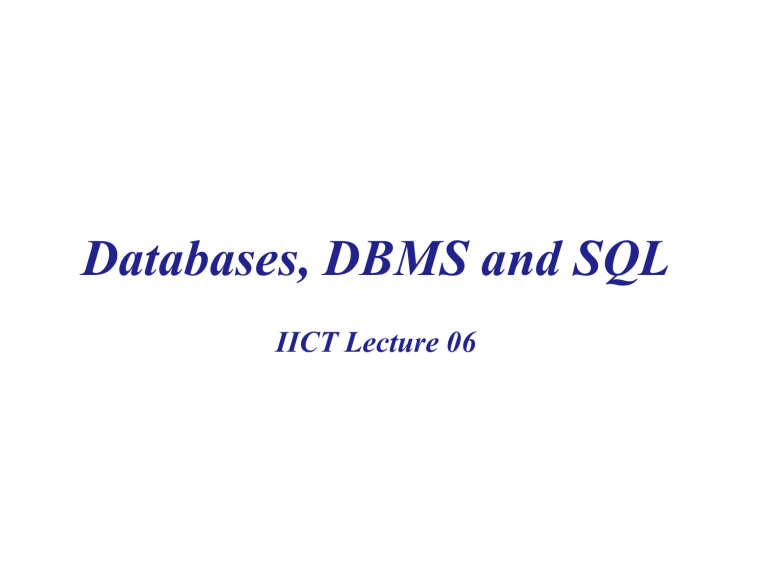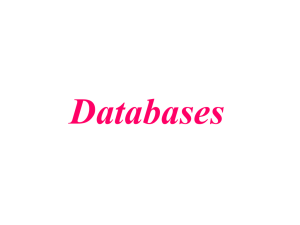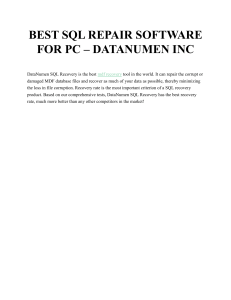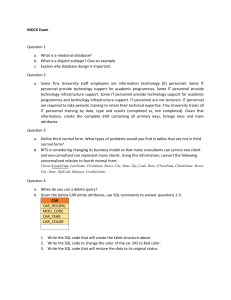
Databases, DBMS and SQL IICT Lecture 06 What is a Database? • An organized collection of Data • A comprehensive collection of related data organized for convenient access, generally in a computer Database Model • Database model defines the logical design of data. • Database model describes the relation between different parts of data. • There are three database models: 1. Hierarchical Model 2. Network Model 3. Relational Model Hierarchical model • Data are organized in an upside down tree • Each entity has one parent and many children • Old and not used now Network model • Entities are organized in a graph • Entities can be accessed through several paths • Old and not used Relational model • Data are organized in two dimensional tables (relations) • Tables re related to each other • Relational Database Management System (RDBMS) are more common model used today Relation (Name, Attributes, Tuples) • Attributes are the column heading Each column must have a unique heading Number of columns is called the degree of the relation • • • • • Tuple is a collection of attribute value Total number of rows is called Cardinality of the relation Each relation must have a unique name Name • Relation appears in 2 dimensional table • That doesn’t mean data stored as table; the physical storage of data is independent of the logical organization of data OPERATIONS ON RELATIONS Insert operation • Unary operation • Insert Operation: Inserts new tuple into the relation Delete operation • Unary operation • Delete Operation: Deletes tuple from the relation Update operation • Unary operation • Update Operation: Changes the values of some attributes of a tuple Select operation • Unary operation • Select Operation: Uses some criteria to select some tuples from the original relation Project operation • Unary operation • Project Operation: Creates relation in which each tuple has fewer attributes Join operation • Binary operation • Join Operation: Takes two relation and combine them based on common attribute Union operation • Binary operation • Union Operation: Creates new relation in which each tuple is either in the first relation, the second relation or in both Intersection operation • Binary operation • Intersection Operation: Creates new relation in which each tuple is in both relations. Difference operation • Binary Operation • Difference Operation: Creates new relation where the new tuples are in the first relation but not in the second. Database Management System • A database management system (DBMS) is system software for creating and managing Database. • The DBMS provides users and programmers with a systematic way to create, retrieve, update and manage data. • DBMS allow all the operations on database discussed in previous slides • Inserte, Delete, retrieve, Union, Join etc… STRUCTURED QUERY LANGUAGE SQL • SQL is the standard language used for relational databases. • It is declarative language where users declare what they want without having to write a step by step procedure. • It was first implemented by Oracle Corporation • SQL stands for Structured Query Language. • SQL is used to communicate with a database. • According to ANSI (American National Standards Institute), it is the standard language for relational database management systems. 1. Insert • SQL Insert Operation format insert into RELATION-NAME values (…, …, …) Insert (Example) insert into COURSES values (“CIS52”, “TCP/IP Protocols”, 6) 2. Delete • SQL Delete Operation format delete from RELATION-NAME where criteria Delete (Example) Delete from COURSES where No = “CIS19” 3. Update • SQL Update Operation format update RELATION-NAME set attribute1 = value1 attribute 2 = value2 … where criteria Update (Example) update COURSES set unit = 6 where No = “CIS51” 4. Select • SQL Select Operation format Select column1, column2, ... from table_name; If you want to select all the fields available in the table, use the following syntax: select from where * RELATION-NAME criteria Select (Example) select * from COURSES where Unit = 5 5. Project • SQL Project Operation format select from attribute-list RELATION-NAME Project (Example) select from No, Unit COURSES 6. Join • SQL Join Operation format select attribute-list from RELATION NO1, RELATION NO2 where criteria Join (Example) select No, Course-Name, Unit, Professor from COURSES, TAUGHT-BY where COURSES.No = TAUGHT-BY.No; 7. Union • SQL Union Operation format select from union select from * RELATION NO1 * RELATION NO2 Union (Example) select from union select from * CIS15-Roster * CIS52-Roster; 8. Intersection • SQL Intersection Operation format select * from RELATION NO1 intersection select * from RELATION NO2 Intersection (Example) select * from CIS15-Roster intersection select * from CIS52-Roster; 9. Difference • SQL Difference Operation format select from minus select from * RELATION NO1 * RELATION NO2 Intersection (Example) select from minus select from * CIS15-Roster * CIS52-Roster; OTHER DATABASE MODELS The levels of Data Database Table (relation) Record/Tuple Field Character Bit One or more tables A collection of Records A group of related fields One or more character At least 8 bits 0 or 1 5 characteristics of Good Database Data Integrity Data Independence Avoiding data Redundancy Data Security Data Maintenance Ensuring data is valid Data is separated from software Repetition of input data is avoided Data is not accessible to unauthorized users Set procedures for adding ,deleting … records for the purpose of optimization How To Write And Run SQL Query • Open your database and click the CREATE tab. – • Click Query Design in the Queries section. – • This will display the ribbon across the top of the window. The Show Table dialog box appears. Select the POWER table. Click the Add button and then click the Close button to close the dialog box. How To Write And Run SQL Query • Click the Home tab and then the View icon in the left corner of the Ribbon. – A menu drops down, displaying the different views available to you in query mode. One of those views is SQL View. • Click SQL View to display the SQL View Object tab. How To Write And Run SQL Query • Fill in an asterisk (*) in the blank area in the first line and add a WHERE clause after the FROM line. – – • If you had already entered some data into the POWER table, you could make a retrieval with something like: SELECT * FROM POWER WHERE LastName = 'Marx' ; Enter a name and then click OK. – Your statement is saved and can be executed as a query later.




